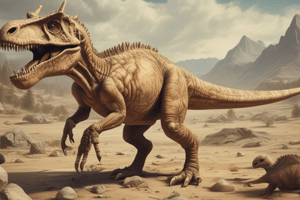Podcast
Questions and Answers
What are the two forms of dinosaur fossils mentioned?
What are the two forms of dinosaur fossils mentioned?
- Mineralized bones and tracks in dried mud flats (correct)
- Shells and preserved nests in glaciers
- Fossilized skin and footprints in volcanic ash
- Teeth and feces found in sedimentary layers
Why are mineralized dinosaur bones and dinosaur tracks rarely found together?
Why are mineralized dinosaur bones and dinosaur tracks rarely found together?
- The conditions required for each type of fossil to form are very different.
- Scavengers that found dinosaur carcasses likely searched mud flats for food. (correct)
- Scavengers likely disturbed both types of fossils, making them difficult to find together.
- Dinosaur bones were primarily formed in forests, whereas tracks were formed in wetlands.
Which of the following statements is most likely true based on the information provided?
Which of the following statements is most likely true based on the information provided?
- Mud flats were the primary habitats for dinosaurs during the Mesozoic era.
- Mineralized bones are often found alongside other prehistoric organic materials.
- Dinosaur tracks indicate a level of social behavior among the species.
- Scavengers were a significant factor in the preservation of dinosaur fossils. (correct)
What might be the expected finding in environments where mineralized bones are typically found?
What might be the expected finding in environments where mineralized bones are typically found?
What does the research suggest about the relationship between dinosaur carcasses and scavenging behaviors?
What does the research suggest about the relationship between dinosaur carcasses and scavenging behaviors?
Study Notes
Dinosaur Fossils
- Dinosaur fossils appear in different forms, primarily as mineralized bones and footprints/tracks.
- Mineralization occurs when organic materials in bones are replaced by minerals, preserving their structure over time.
- Dinosaur tracks are fossilized impressions left in mud that hardens over time, providing insights into their behavior and movement.
Rarity of Co-occurrence
- Mineralized bones and tracks are rarely found together in the same location.
- This rarity is attributed to the habitats and behaviors of scavenger species that consumed dinosaur carcasses.
- Scavengers likely inhabited mud flats, searching for food, which explains the separation of fossil types in different areas.
Studying That Suits You
Use AI to generate personalized quizzes and flashcards to suit your learning preferences.
Description
This quiz explores the various forms of dinosaur fossils, including mineralized bones and tracks found in dried mud flats. Discover why these two forms are rarely found together and the behavior of scavengers in relation to these fossils.




